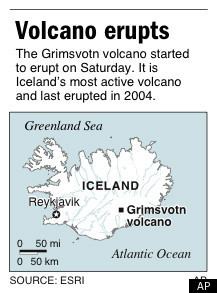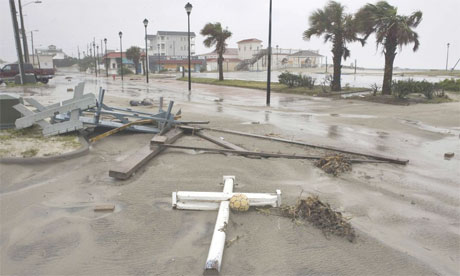One of the most financially damaging disasters in the Southern United States has been the streak of wildfires sweeping across Texas. Doing much more than demonstrating developed countries' tendency to not expect natural disasters to continue after periods of development, these fires have pressed a political issue with a presidential candidate. Rick Perry, normally a staunch defender of the idea that government spending is superfluous, has had to reverse his position for the sake of his constituents. The fires, which have raged over 3.6 million acres of land in the state, have claimed an unprecedented number of homes and businesses.
One concern that may seem depressingly unlikely is nevertheless true: military construction equipment, the one bit of government-funded property that Rick Perry supports, has in some cases gone unused due to security regulations. Hopefully the debate between conservatives and liberals can be set aside in future, at least for the duration of the town being on fire.
((Article at: http://www.dailymail.co.uk/news/article-2034549/Texas-wildfires-Death-toll-rises-4-fires-rage-turning-hundreds-homes-rubble-ash.html))
Tuesday, December 13, 2011
The Tuvalu Drought: A Microcosm of Things to Come
As climate change looms, there are few better vanguard countries to keep an eye on than Tuvalu. A series of islands in the Pacific, the atoll nation's highest point is 5m above sea level, and is the perfect testing ground for issues relating to the interaction between human development and environmental change. It is extremely susceptible to not only rising tides, but also fluctuations in weather patterns. This year, it has been devastated by a drought so severe as to beg the question - is it feasible to continue to live there? Regardless of the answer, many residents below a certain income level are trapped. Emigration is high, and many families would do so if they could. However, there are also members of another camp, including the chairman of the national disaster committee. Disturbingly, he takes a c'est-la-vie position when asked about the prospects of living in a potentially dying country.
In the light of recent retractions and setbacks in the battle against climate change, the attitudes in Tuvalu raise questions as to how first-world countries will deal with these same issues when their time comes. If it is to be taken as an example, we may need to ensure that our leaders are not simply waiting for the inevitable by voting with the highest priority given to candidates' stances on climate change.
((Article at: http://www.guardian.co.uk/world/2011/oct/17/tuvalu-drought-climate-change
Image from: http://news.bbc.co.uk/2/hi/asia-pacific/648373.stm))
In the light of recent retractions and setbacks in the battle against climate change, the attitudes in Tuvalu raise questions as to how first-world countries will deal with these same issues when their time comes. If it is to be taken as an example, we may need to ensure that our leaders are not simply waiting for the inevitable by voting with the highest priority given to candidates' stances on climate change.
((Article at: http://www.guardian.co.uk/world/2011/oct/17/tuvalu-drought-climate-change
Image from: http://news.bbc.co.uk/2/hi/asia-pacific/648373.stm))
New Orleans and Tropical Storm Lee - Good News, Finally
Too often as of late have relief efforts failed, warning systems been too late, and evacuation orders been ignored. This was not the case with Tropical Storm Lee, with which Obama's state of emergency order saw the evacuation of over a hundred thousand individuals in the United States. At the time of one of the articles' writing, over 100,000 people had been evacuated with 14 casualties. Considering the developmental level of the United States, this displacement will have much less of an impact on the population than, say, many times more than that being displaced due to conflicts in Africa. All in all, the response to Lee can be counted as a success.
((Article at: http://www.nasa.gov/mission_pages/hurricanes/archives/2011/h2011_Lee.html))
((Article at: http://www.nasa.gov/mission_pages/hurricanes/archives/2011/h2011_Lee.html))
Retreating Artic Ice Releases Methane
Over the last twenty years, the survey area in the Arctic Ocean has never seen anything quite like this: 20 times the average amount of carbon dioxide has been bubbling to the surface. While studying the seabed, they discovered “torch-like structures”, possibly numbering in the thousands. In theory, there could be hundreds of millions of tones of methane under the Arctic permafrost, which is shrinking quickly, and as it does so, this could release the gas beneath the surface, and damage the atmosphere.
((Article at: http://www.independent.co.uk/environment/climate-change/shock-as-retreat-of-arctic-sea-ice-releases-deadly-greenhouse-gas-6276134.html))
UK Heat Wave
At a time when starvation runs rampant in Africa, an anomalous meteorological event this autumn in the UK was met with a different reaction. The development paradigm is clearly at work in the consequences of a potentially drought-causing heat wave were the UK to have Africa's infrastructure or political climate. To quote the article, "a lamb has been born early and a field of about 100 sunflowers have blossomed near Bamburgh castle". This can either be taken as a mark of proper preparedness on the part of the UK, or as indicative of a severe disproportion in global economic distribution.
((Article at: http://www.bbc.co.uk/news/uk-england-15107937))
Grimsvotn Eruption
In a case of internationally joined efforts to reduce risk in line with the behavioral paradigm, flights were shut down in May this year over a 120-square mile area in Iceland. This was a necessary step, as much of that area was obscured by a pillar of ash and debris kicked up by the Grimsvotn eruption. 370 flights were canceled, and rightfully so.
((Article at: http://www.huffingtonpost.com/2011/05/21/grimsvotn-eruption-2011-iceland-volcano_n_865150.html#s282574&title=Iceland_Volcano_Eruption))
((Article at: http://www.huffingtonpost.com/2011/05/21/grimsvotn-eruption-2011-iceland-volcano_n_865150.html#s282574&title=Iceland_Volcano_Eruption))
Government Regulations: There For a Reason
Despite building codes and disaster prevention plans, a Malaysian orphanage saw a smaller scale tragedy this year. Over a dozen children and their guardian were outside near a tent when a landslide occurred, burying the lot of them. Recovery efforts took most of a day, and were too late to save the lives of the victims. Speaking from the behavioural paradigm, this case may be attributed to both terrible timing and a risky decision made in face of recent torrential rains.
((Article at: http://articles.nydailynews.com/2011-05-21/news/29588538_1_rescuers-search-landslide-orphanage
Image from:http://today.msnbc.msn.com/id/43119471/ns/today-today_news/t/landslides-kill-malaysian-orphanage/))
((Article at: http://articles.nydailynews.com/2011-05-21/news/29588538_1_rescuers-search-landslide-orphanage
Image from:http://today.msnbc.msn.com/id/43119471/ns/today-today_news/t/landslides-kill-malaysian-orphanage/))
Chile Volcano Eruption
Sometimes, pictures are more effective than words at conveying the scope of a natural disaster. Facts and figures can describe the damages caused by eruptions such as that of Puyuhue in Chile this year, but a chart often fails to bring to mind words such as "apocalyptic", "fearsome", or "divine wrath". I'll let this picture speak for itself.
((Article from: http://www.theatlantic.com/infocus/2011/06/chiles-puyehue-volcano-erupts/100081/))
((Article from: http://www.theatlantic.com/infocus/2011/06/chiles-puyehue-volcano-erupts/100081/))
Hurricane Preparation: Panic at its Worst
When facing an imminent crisis, judging from events that have taken place in the UK due to hurricane Irene, it is definitely better know. Matt Seaton and Matt Wells of the Guardian took it upon themselves to document the chaos that precluded the event, as well as the aftermath. Most of the toll was taken on people who flaunted the dangers, and in several areas of the US such as North Carolina, shelters provided by government organizations went woefully underused. Though supermarkets along the Eastern seaboard managed to get rid of their overstocks, the well-researched contingency plans seem to have fallen on deaf ears. There was even one case in Florida of a surfer attempting to ride the waves caused by the storm being killed - Darwinism, as well as the behavioural paradigm, in action.
((Article from: http://www.guardian.co.uk/world/blog/2011/aug/27/hurricane-irene-new-york-live))
((Article from: http://www.guardian.co.uk/world/blog/2011/aug/27/hurricane-irene-new-york-live))
Lack of Opportunity in Eastern Africa
Nowhere else is the development paradigm more discussed than in Africa, the highest concentration of underdeveloped countries in the world. In a continent plagued by third world problems, a recent example can be found in the consequences of droughts on an already difficult situation. Misplaced and separated families have difficulties enough, with a third of all children suffering from acute malnourishment. Add to that a less resilient infrastructure due to political instability and conflict, and the problem becomes clear. When a drought like the one that has swept the area in late spring/early summer this year hits, there is not enough of a safety net to stop the increase in starvation.
Perhaps the most discouraging aspect of this crisis is the first group to fall: children. Estimates in Somalia are that one in ten children is at a high risk of dying of starvation, and this will only get worse if the estimated 500,000 children at risk of being displaced are forced to relocate.
((Article from: http://www.thestar.com/news/world/article/1025162--east-africa-drought-the-most-severe-humanitarian-emergency-in-the-world
Image from: http://soils.usda.gov/use/worldsoils/papers/desertification-africa.html))
Perhaps the most discouraging aspect of this crisis is the first group to fall: children. Estimates in Somalia are that one in ten children is at a high risk of dying of starvation, and this will only get worse if the estimated 500,000 children at risk of being displaced are forced to relocate.
((Article from: http://www.thestar.com/news/world/article/1025162--east-africa-drought-the-most-severe-humanitarian-emergency-in-the-world
Image from: http://soils.usda.gov/use/worldsoils/papers/desertification-africa.html))
Inevitable, but Unfortunate - Property Destruction in Thailand
Improper building techniques in areas susceptible to flooding are a recipe for disaster, but sometimes it is unavoidable. This was the case earlier this year in Thailand, known around the world for its architectural beauty. Unfortunately, many of the ancient sites frequented by tourists as well as religious pilgrims were built long before recent innovations in flood protection. An area that had been spared for centuries was hit by flooding, the capital of Ayatthuya. A staggering amount of cultural damage has been done, with over 200 monasteries and other historic buildings now steeping like so much tea in the waters that have relented for so long.
((Article at: http://www.weather.com/life/safety/flood/article/thailand-flooding_2011-10-17
Image from: http://www.mnn.com/green-tech/gadgets-electronics/photos/eco-photos-of-the-week-oct-17-23/thailand-flooding))
((Article at: http://www.weather.com/life/safety/flood/article/thailand-flooding_2011-10-17
Image from: http://www.mnn.com/green-tech/gadgets-electronics/photos/eco-photos-of-the-week-oct-17-23/thailand-flooding))
Himalyan Quake
Even in the light of recent increases in the extremity of weather, an earthquake's causes can hardly be blamed on human influences. However, the consequences of a quake can illustrate disaster preparedness, and (under the development paradigm) the reaction times of relief personnel. Deaths are estimated to have passed 100, and the reason for the lack of specificity in this estimate is the damage done to already-minimal access to rural areas. Helicopters were prioritized to save trapped individuals and verify safety, so contact with outlying towns to determine any deaths was impossible by the time the article was written.
Ironically enough, in Sikkim efforts to improve local infrastructure may have inadvertently led to a large proportion of the deaths. 17 workers in the process of constructing a hydroelectric dam were killed in the resulting landslides.
((Article at: http://www.voanews.com/english/news/asia/Death-Toll-in-Himalayan-Quake-Reaches-100-130265183.html
Image from: http://frontierindia.net/news/sikkim-earthquake-toll-rises-to-25-killed-as-help-battles-adverse-weather/ ))
Ironically enough, in Sikkim efforts to improve local infrastructure may have inadvertently led to a large proportion of the deaths. 17 workers in the process of constructing a hydroelectric dam were killed in the resulting landslides.
((Article at: http://www.voanews.com/english/news/asia/Death-Toll-in-Himalayan-Quake-Reaches-100-130265183.html
Image from: http://frontierindia.net/news/sikkim-earthquake-toll-rises-to-25-killed-as-help-battles-adverse-weather/ ))
Subscribe to:
Posts (Atom)











